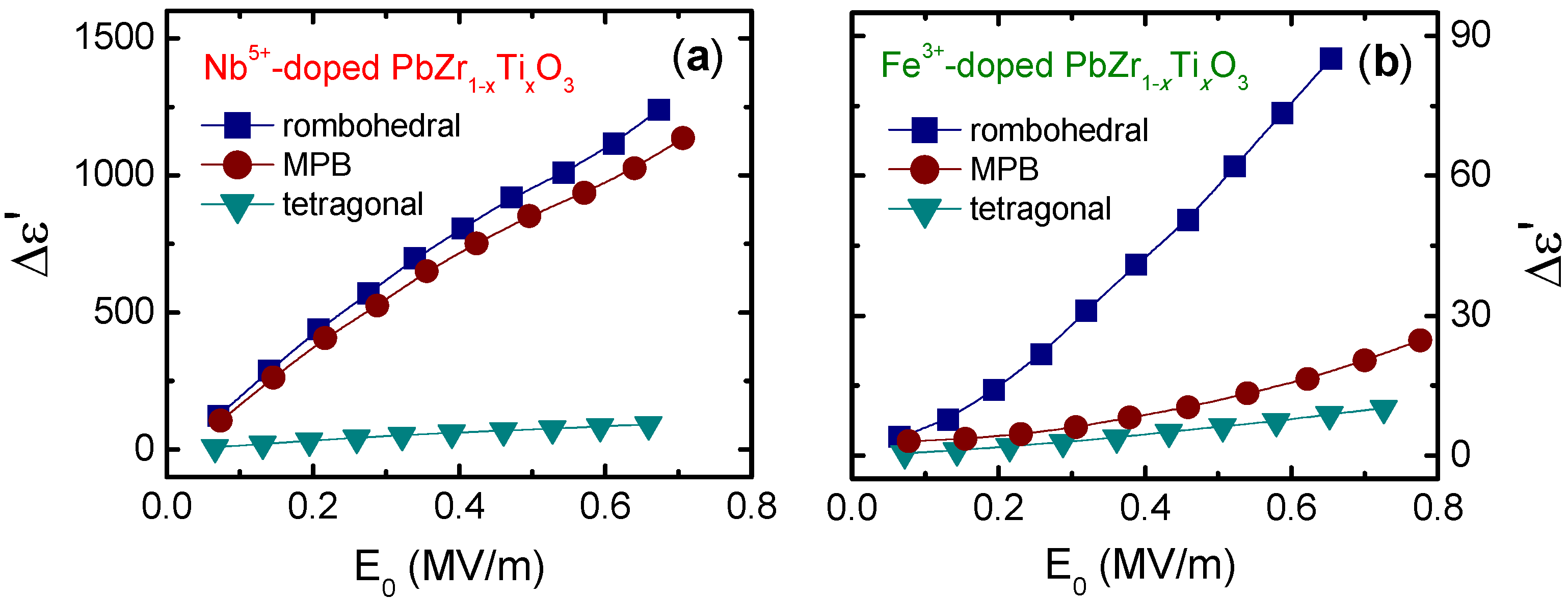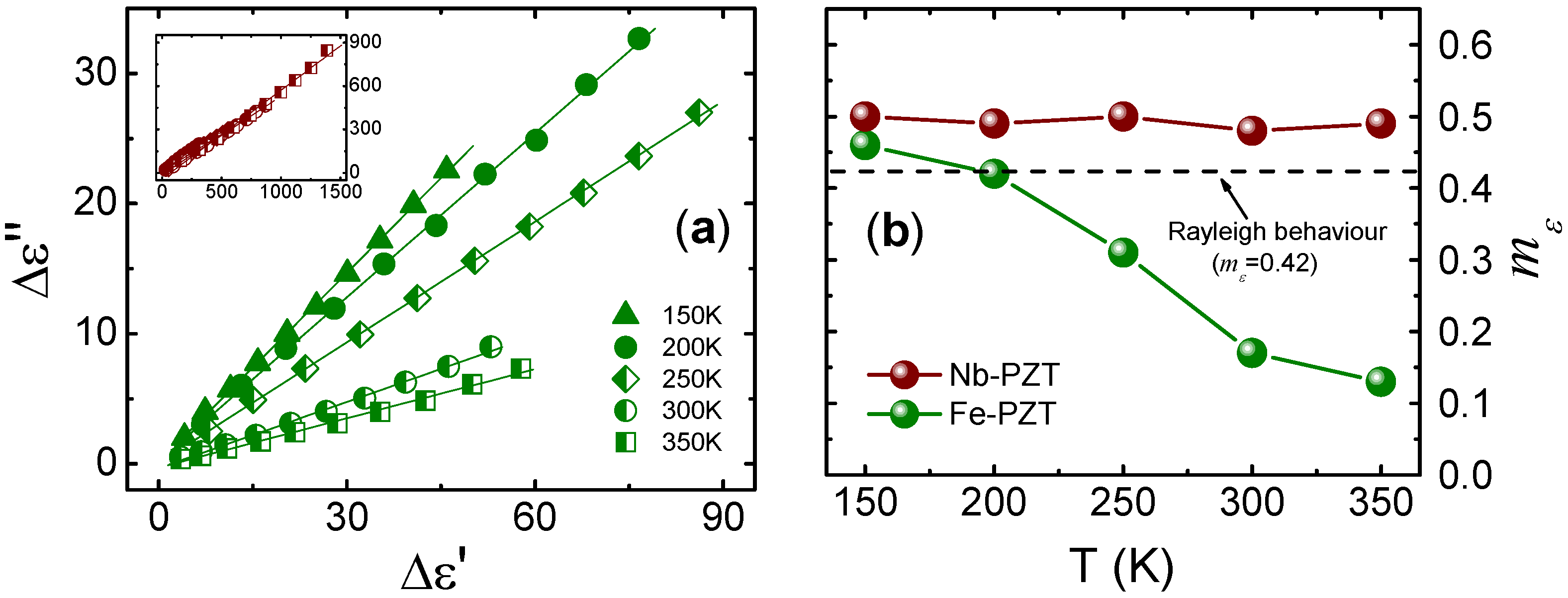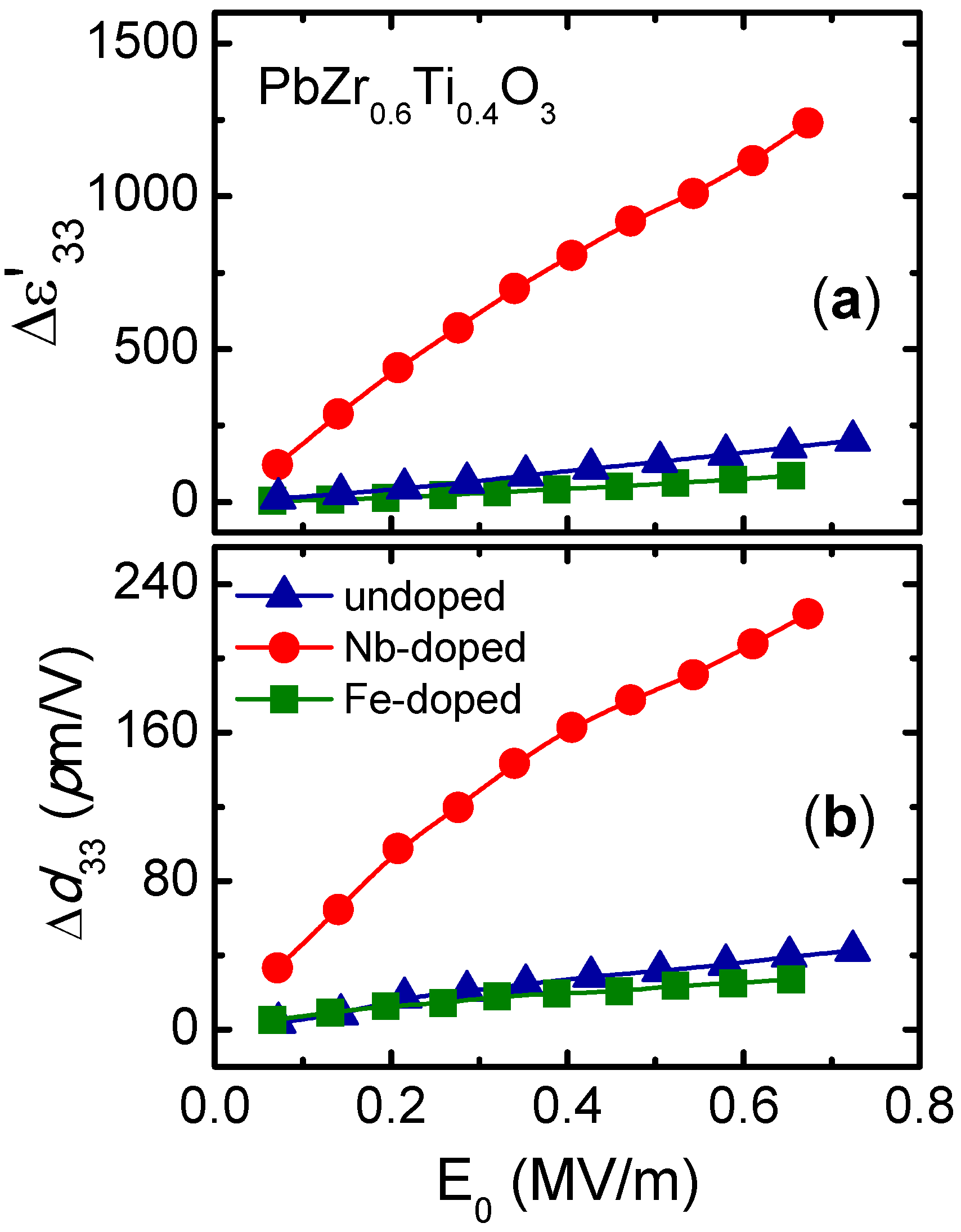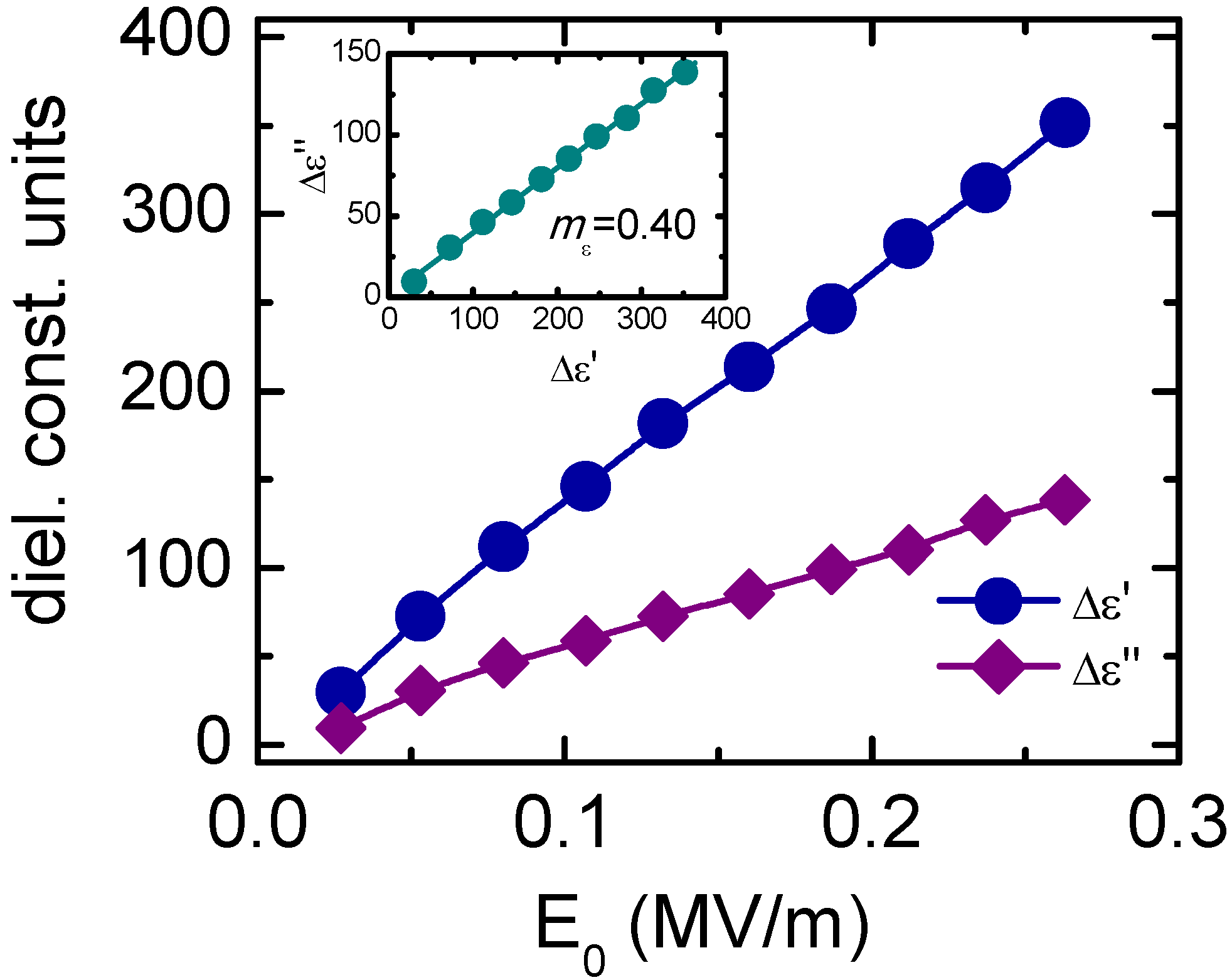Extrinsic Contribution and Instability Properties in Lead-Based and Lead-Free Piezoceramics
Abstract
:1. Introduction
2. Extrinsic Contribution and Nonlinear Response


2.1. Extrinsic Origin of the Nonlinear Response

2.2. Domain Wall Dynamics

3. Nonlinearity in Lead-Based Piezoceramics
3.1. Crystallographic Phase Effect

3.2. Doping Effects

3.3. Grain Size Effect
4. Nonlinearity in Lead-Free Piezoceramics
4.1. KNN-Based Compositions

4.2. Other Lead-Free Piezoceramics

5. Final Remarks and Outlook
Acknowledgments
Conflicts of Interest
References
- Uchino, K. Ferroelectric Devices, 2nd ed.; CRC Press: Boca Raton, FL, USA, 2010. [Google Scholar]
- Advanced Piezoelectric Materials: Science and Technology; Uchino, K. (Ed.) Woodhead Publishing Limited: Canbridge, UK, 2010.
- Jo, W.; Dittmer, R.; Acosta, M.; Zang, J.; Groh, C.; Sapper, E.; Wang, K.; Rödel, J. Giant electric-field-induced strains in lead-free ceramics for actuator applications—Status and perspective. J. Electroceramics 2012, 29, 71–93. [Google Scholar] [CrossRef]
- Jaffe, B.; Cook, W., Jr.; Jaffe, H. Piezoelectric Ceramics; Academic Press: London, UK, 1971. [Google Scholar]
- Damjanovic, D. A morphotropic phase boundary system based on polarization rotation and polarization extension. Appl. Phys. Lett. 2010, 97. [Google Scholar] [CrossRef]
- Zhang, Q.M.; Wang, H.; Kim, N.; Cross, L.E. Direct evaluation of domain wall and intrinsic contributions to the dielectric and piezoelectric response and their temperature dependence on lead zirconate titanate. J. Appl. Phys. 1994, 75, 454–459. [Google Scholar] [CrossRef]
- Bellaiche, L.; Garcia, A.; Vanderbilt, D. Finite-temperature properties of Pb(Zr1−xTix)O3 alloys from first principles. Phys. Rew. Lett. 2000, 84, 5427–5430. [Google Scholar] [CrossRef] [PubMed]
- Tutuncu, G.; Li, B.; Bowman, K.; Jones, J.L. Domain wall motion and electromechanical strain in lead-free piezoelectrics: Insight from the model system (1−x)Ba(Zr0.2Ti0.8)O3–x(Ba0.7Ca0.3)TiO3 using in situ high-energy X-ray diffraction during application of electric fields. J. Appl. Phys. 2014, 115. [Google Scholar] [CrossRef]
- Noheda, B.; Cox, D.E.; Shirane, G.; Guo, R.; Jones, B.; Cross, L.E. Stability of the monoclinic phase in the ferroelectric perovskite PbZr1−xTixO3. Phys. Rev. B 2000, 63. [Google Scholar] [CrossRef]
- Ge, W.W.; Ren, Y.; Zhang, J.L.; Devreugd, C.P.; Li, J.F.; Viehland, D. A monoclinic-tetragonal ferroelectric phase transition in lead-free (K0.5Na0.5)NbO3−x%LiNbO3 solid solution. J. Appl. Phys. 2012, 111. [Google Scholar] [CrossRef]
- Damjanovic, D. Ferroelectric, dielectric and piezoelectric properties of ferroelectric thin films and ceramics. Rep. Prog. Phys. 1998, 61, 1267–1324. [Google Scholar] [CrossRef]
- Hall, D. Nonlinearity in piezoelectric ceramics. J. Mater. Sci. 2001, 36, 4575–4601. [Google Scholar] [CrossRef]
- Zhang, Q.M.; Pan, W.Y.; Jang, S.J.; Cross, L.E. Domain wall excitations and their contributions to the weak-signal response of doped lead zirconate titanate ceramics. J. Appl. Phys. 1968, 64, 6445–6451. [Google Scholar] [CrossRef]
- Damjanovic, D. Stress and frequency dependency of the direct piezoelectric effect in ferroelectric ceramics. J. Appl. Phys. 1997, 82, 1788–1797. [Google Scholar] [CrossRef]
- Garcia, J.E.; Pérez, R.; Albareda, A.; Eiras, J.A. Non-linear dielectric and piezoelectric response in undoped and Nb5+ or Fe3+ doped PZT ceramic system. J. Eur. Ceram. Soc. 2007, 27, 4029–4032. [Google Scholar] [CrossRef]
- Albareda, A.; Pérez, R.; Casals, J.A.; García, J.E.; Ochoa, D.A. Optimization of elastic nonlinear behavior measurements of ceramic piezoelectric resonators with burst excitation. IEEE Trans. Ultrason. Ferroelectr. Freq. Control 2007, 54, 2175–2188. [Google Scholar] [CrossRef] [PubMed]
- Jiang, W.; Cao, W. Nonlinear properties of lead zirconate–titanate piezoceramics. J. Appl. Phys. 2000, 88, 6684–6689. [Google Scholar] [CrossRef]
- Priya, S.; Viehland, D.; Carazo, A.V.; Ryu, J.; Uchino, K. High-power resonant measurements of piezoelectric materials: Importance of elastic nonlinearities. J. Appl. Phys. 2001, 90, 1469–1479. [Google Scholar] [CrossRef]
- Blackburn, J.F.; Cain, M.G. Nonlinear piezoelectric resonance: A theoretically rigorous approach to constant I–V measurements. J. Appl. Phys. 2006, 100. [Google Scholar] [CrossRef]
- Ahmed, A.; Goldthorpe, I.; Khandani, A.K. Electrically tunable materials for microwave applications. Appl. Phys. Rev. 2015, 2. [Google Scholar] [CrossRef]
- Maiti, T.; Guo, R.; Bhalla, A.S. Electric field dependent dielectric properties and high tunability of BaZrxTi1−xO3 relaxor ferroelectrics. Appl. Phys. Lett. 2006, 89. [Google Scholar] [CrossRef]
- Curecheriu, L.; Buscaglia, M.T.; Buscaglia, V.; Zhao, Z.; Mitoseriu, L. Grain size effect on the nonlinear dielectric properties of barium titanate ceramics. Appl. Phys. Lett. 2010, 97. [Google Scholar] [CrossRef]
- Damjanovic, D. Contributions to the piezoelectric effect in ferroelectric single crystals and ceramics. J. Am. Ceram. Soc. 2005, 88, 2663–2676. [Google Scholar] [CrossRef]
- Damjanovic, D.; Demartin, M. Contribution of the irreversible displacement of domain walls to the piezoelectric effect in barium titanate and lead zirconate titanate ceramics. J. Phys. Condens. Matter 1997, 9, 4943–4953. [Google Scholar] [CrossRef]
- Chaplya, P.M.; Carman, G.P. Dielectric and piezoelectric response of lead zirconate-lead titanate at high electric and mechanical loads in terms of non-180° domain wall motion. J. Appl. Phys. 2001, 90, 5278–5286. [Google Scholar] [CrossRef]
- García, J.E.; Pérez, R.; Ochoa, D.A.; Albareda, A.; Lente, M.H.; Eiras, J.A. Evaluation of domain wall motion in lead zirconate titanate ceramics by nonlinear response measurements. J. Appl. Phys. 2008, 103. [Google Scholar] [CrossRef]
- Perez-Delfin, E.; García, J.E.; Ochoa, D.A.; Pérez, R.; Guerrero, F.; Eiras, J.A. Effect of Mn-acceptor dopant on dielectric and piezoelectric responses of lead lanthanum zirconate titanate piezoceramics. J. Appl. Phys. 2011, 110. [Google Scholar] [CrossRef]
- Demartin, M.; Damjanovic, D. Dependence of the direct piezoelectric effect in coarse and fine grain barium titanate ceramics on dynamic and static pressure. Appl. Phys. Lett. 1996, 68, 3046–3048. [Google Scholar] [CrossRef]
- Garcia, J.E.; Guerra, J.D.S.; Araújo, E.B.; Perez, R. Domain wall contribution to dielectric and piezoelectric responses in 0.65Pb(Mg1/3Nb2/3)O3-PbTiO3 ferroelectric ceramics. J. Phys. D Appl. Phys. 2009, 42. [Google Scholar] [CrossRef]
- Ochoa, D.A.; García, J.E.; Pérez, R.; Gomis, V.; Albareda, A.; Rubio-Marcos, F.; Fernández, J.F. Extrinsic contribution and non-linear response in lead-free KNN-modified piezoceramics. J. Phys. D Appl. Phys. 2009, 42. [Google Scholar] [CrossRef]
- Gao, J.; Hu, X.; Zhang, L.; Li, F.; Zhang, L.; Wang, Y.; Hao, Y.; Zhong, L.; Ren, X. Major contributor to the large piezoelectric response in (1−x)Ba(Zr0.2Ti0.8)O3−x(Ba0.7Ca0.3)TiO3 ceramics: domain wall motion. Appl. Phys. Lett. 2014, 104. [Google Scholar] [CrossRef]
- Ochoa, D.A.; Garcia, J.E.; Pérez, R.; Albareda, A. Influence of extrinsic contribution on the macroscopic properties of hard and soft lead zirconate titanate ceramics. IEEE Trans. Ultrason. Ferroelectr. Freq. Control 2008, 55, 2732–2736. [Google Scholar] [CrossRef] [PubMed]
- Zhang, X.L.; Chen, Z.X.; Cross, L.E.; Schulze, W.A. Dielectric and piezoelectric properties of modified lead zirconate titanate ceramics from 4.2 to 300 K. J. Mater. Sci. 1983, 18, 968–972. [Google Scholar] [CrossRef]
- Iamsasri, T.; Tutuncu, G.; Uthaisar, C.; Pojprapai, S.; Jones, J.L. Analysis methods for characterizing ferroelectric/ferroelastic domain reorientation in orthorhombic perovskite materials and application to Li-doped Na0.5K0.5NbO3. J. Mater. Sci. 2013, 48, 6905–6910. [Google Scholar] [CrossRef]
- Garcia, J.E.; Gomis, V.; Perez, R.; Albareda, A.; Eiras, J.A. Unexpected dielectric response in lead zirconate titanate ceramics: The role of ferroelectric domain wall pinning effects. Appl. Phys. Lett. 2007, 91. [Google Scholar] [CrossRef]
- García, J.E.; Pérez, R.; Albareda, A. High electric field measurement of dielectric constant and losses of ferroelectric ceramics. J. Phys. D Appl. Phys. 2001, 34, 3279–3284. [Google Scholar] [CrossRef]
- Li, S.; Cao, W.; Cross, L.E. The extrinsic nature of nonlinear behavior observed in lead zirconate titanate ferroelectric ceramic. J. Appl. Phys. 1991, 69, 7219–7224. [Google Scholar] [CrossRef]
- Garcia, J.E.; Ochoa, D.A.; Gomis, V.; Eiras, J.A.; Pérez, R. Evidence of temperature dependent domain wall dynamics in hard lead zirconate titanate piezoceramics. J. Appl. Phys. 2012, 112. [Google Scholar] [CrossRef] [Green Version]
- Damjanovic, D.; Demartin, M. The Rayleigh law in piezoelectric ceramics. J. Phys. D Appl. Phys. 1996, 29, 2057–2060. [Google Scholar] [CrossRef]
- García, J.E.; Pérez, R.; Albareda, A. Contribution of reversible processes to the non-linear dielectric response in hard lead zirconate titanate ceramics. J. Phys. Condens. Matter 2005, 17, 7143–7150. [Google Scholar] [CrossRef]
- Hall, D.A.; Stevenson, P.J. Field-induced desestabilisation of hard PZT ceramics. Ferroelectrics 1996, 187, 23–37. [Google Scholar] [CrossRef]
- Mueller, V.; Zhang, Q.M. Shear response of lead zirconate titanate piezoceramics. J. Appl. Phys. 1998, 83, 3754–3761. [Google Scholar] [CrossRef]
- Alilat, K.; Thi, M.P.; Dammak, H.; Bogicevic, C.; Albareda, A.; Doisy, M. Grain size effect on electromechanical properties and non-linear response of dense nano and microstructured PIN-PT ceramics. J. Eur. Ceram. Soc. 2010, 30, 1919–1924. [Google Scholar] [CrossRef]
- Peng, B.; Yue, Z.; Li, L. Evaluation of domain wall motion during polymorphic phase transition in (K,Na)NbO3-based piezoelectric ceramics by nonlinear response measurements. J. Appl. Phys. 2011, 109. [Google Scholar] [CrossRef]
- Robert, G.; Damjanovic, D.; Setter, N. Preisach distribution function approach to piezoelectric nonlinearity and hysteresis. J. Appl. Phys. 2001, 90, 2459–2464. [Google Scholar] [CrossRef]
- Damjanovic, D. Hysteresis in Piezoelectric and Ferroelectric Materials. In The Science of Hysteresis, Vol III. Hysteresis in Materials; Bertotti, G., Mayergoyz, I.D., Eds.; Academic Press: Oxford, UK, 2006; pp. 337–465. [Google Scholar]
- Robert, G.; Damjanovic, D.; Setter, N. Preisach modeling of ferroelectric pinched loops. Appl. Phys. Lett. 2000, 77, 4413–4415. [Google Scholar] [CrossRef]
- Ochoa, D.A.; Pérez, R.; García, J.E. Preisach modelling of nonlinear response in electrically biased lead zirconate titanate-based piezoceramics. Appl. Phys. A 2013, 112, 1081–1088. [Google Scholar] [CrossRef] [Green Version]
- Eitel, R.E.; Shrout, T.R.; Randall, C.A. Nonlinear contributions to the dielectric permittivity and converse piezoelectric coefficient in piezoelectric ceramics. J. Appl. Phys. 2006, 99. [Google Scholar] [CrossRef]
- Rubio-Marcos, F.; Del Campo, A.; López-Juárez, R.; Romero, J.J.; Fernández, J.F. High spatial resolution structure of (K,Na)NbO3 lead-free ferroelectric domains. J. Mater. Chem. 2012, 22, 9714–9720. [Google Scholar] [CrossRef]
- Rubio-Marcos, F.; Del Campo, A.; Fernández, J.F. Resolution of the ferroelectric domains structure in (K,Na)NbO3-based lead-free ceramics by confocal Raman microscopy. J. Appl. Phys. 2013, 113. [Google Scholar] [CrossRef]
- Eichel, R.-A. Defect structure of oxide ferroelectrics—Valence state, site of incorporation, mechanisms of charge compensation and internal bias fields. J. Electroceramics 2007, 19, 11–23. [Google Scholar] [CrossRef]
- Warren, W.L.; Pike, G.E.; Vanheusden, K.; Dimos, D.; Tuttle, B.A.; Robertson, J. Defect-dipole alignment and tetragonal strain in ferroelectrics. J. Appl. Phys. 1996, 79, 9250–9257. [Google Scholar] [CrossRef]
- Zhang, Z.; Wu, P.; Lu, L.; Shu, C. Study on vacancy formation in ferroelectric PbTiO3 from ab initio. Appl. Phys. Lett. 2006, 88. [Google Scholar] [CrossRef]
- Zhang, Z.; Lu, L.; Shu, C.; Wu, P. Computational investigation of B-site donor doping effect on fatigue behavior of lead zirconate titanate. Appl. Phys. Lett. 2006, 89. [Google Scholar] [CrossRef]
- Vendrell, X.; García, J.E.; Rubio-Marcos, F.; Ochoa, D.A.; Mestres, L.; Fernández, J.F. Exploring different sintering atmospheres to reduce nonlinear response of modified KNN piezoceramics. J. Eur. Ceram. Soc. 2013, 33, 825–831. [Google Scholar] [CrossRef]
- Setter, N.; Waser, R. Electroceramic materials. Acta Mater. 2000, 48, 151–178. [Google Scholar] [CrossRef]
- Arlt, G.; Hennings, D.; de With, G. Dielectric properties of fine-grained barium titanate ceramics. J. Appl. Phys. 1985, 58, 1619–1625. [Google Scholar] [CrossRef]
- Zhao, Z.; Buscaglia, V.; Viviani, M.; Buscaglia, M.T.; Mitoseriu, L.; Testino, A.; Nygren, M.; Johnsson, M.; Nanni, P. Grain-size effects on the ferroelectric behavior of dense nanocrystalline BaTiO3 ceramics. Phys. Rev. B 2004, 70. [Google Scholar] [CrossRef]
- Randall, C.A.; Kim, N.; Kucera, J.-P.; Cao, W.; Shrout, T.R. Intrinsic and extrinsic size effects in fine-grained morphotropic-phase-boundary lead zirconate titanate ceramics. J. Am. Ceram. Soc. 1998, 81, 677–688. [Google Scholar] [CrossRef]
- Algueró, M.; Ricote, J.; Jiménez, R.; Ramos, P.; Carreaud, J.; Dkhil, B.; Kiat, J.M.; Holc, J.; Kosec, M. Size effect in morphotropic phase boundary Pb(Mg1/3Nb2/3)O3–PbTiO3. Appl. Phys. Lett. 2007, 91. [Google Scholar] [CrossRef]
- Saito, Y.; Takao, H.; Tani, T.; Nonoyama, T.; Takatori, K.; Homma, T.; Nagaya, T.; Nakamura, M. Lead-free piezoceramics. Nature 2004, 432, 84–87. [Google Scholar] [CrossRef] [PubMed]
- Maeder, M.D.; Damjanovic, D.; Setter, N. Lead free piezoelectric materials. J. Electroceramics 2004, 13, 385–392. [Google Scholar] [CrossRef]
- Takenaka, T.; Nagata, H. Current status and prospects of lead-free piezoelectric ceramics. J. Eur. Ceram. Soc. 2005, 25, 2693–2700. [Google Scholar] [CrossRef]
- Shrout, T.R.; Zhang, S.J. Lead-free piezoelectric ceramics: alternatives for PZT? J. Electroceramics 2007, 19, 113–126. [Google Scholar] [CrossRef]
- Takenaka, T.; Nagata, H.; Hiruma, Y. Current developments and prospective of lead-free piezoelectric ceramics. Jpn. J. Appl. Phys. 2008, 47, 3787–3801. [Google Scholar] [CrossRef]
- Panda, P.K. Review: Environmental friendly lead-free piezoelectric materials. J. Mater. Sci. 2009, 44, 5049–5062. [Google Scholar] [CrossRef]
- Rödel, J.; Jo, W.; Seifert, K.T.P.; Anton, E.-M.; Granzow, T.; Damjanovic, D. Perspective on the development of lead-free piezoceramics. J. Am. Ceram. Soc. 2009, 92, 1153–1177. [Google Scholar] [CrossRef]
- Aksel, E.; Jones, J.L. Advances in lead-free piezoelectric materials for sensors and actuators. Sensors 2010, 10, 1935–1954. [Google Scholar] [CrossRef] [PubMed]
- Xiao, D. Progresses and further considerations on the research of perovskite lead-free piezoelectric ceramics. J. Adv. Dielectr. 2011, 1, 33–40. [Google Scholar] [CrossRef]
- Shvartsman, V.V.; Lupascu, D.C. Lead-free relaxor ferroelectrics. J. Am. Ceram. Soc. 2012, 95, 1–26. [Google Scholar] [CrossRef]
- Coondoo, I.; Panwar, N.; Kholkin, A. Lead-free piezoelectrics: Current status and perspectives. J. Adv. Dielectr. 2013, 3. [Google Scholar] [CrossRef]
- Li, J.-F.; Wang, K.; Zhu, F.-Y.; Cheng, L.-Q.; Yao, F.-Z. (K,Na)NbO3-based lead-free piezoceramics: Fundamental aspects, processing technologies, and remaining challenges. J. Am. Ceram. Soc. 2013, 96, 3677–3696. [Google Scholar] [CrossRef]
- Rödel, J.; Webber, K.G.; Dittmer, R.; Jo, W.; Kimura, M.; Damjanovic, D. Transferring lead-free piezoelectric ceramics into application. J. Eur. Ceram. Soc. 2015, 35, 1659–1681. [Google Scholar] [CrossRef]
- Safari, A.; Abazari, M.; Kerman, K.; Marandian-Hagh, N.; Akdo, E.K. (K0.44Na0.52Li0.04)(Nb0.86Ta0.10Sb0.04)O3 ferroelectric ceramics. IEEE Trans. Ultrason. Ferroelectr. Freq. Control 2009, 56, 1586–1594. [Google Scholar] [CrossRef] [PubMed]
- Akdoğan, E.K.; Kerman, K.; Abazari, M.; Safari, A. Origin of high piezoelectric activity in ferroelectric (K0.44Na0.52Li0.04)–(Nb0.86Ta0.10Sb0.04)O3 ceramics. Appl. Phys. Lett. 2008, 92. [Google Scholar] [CrossRef]
- Rubio-Marcos, F.; Ochoa, P.; Fernandez, J.F. Sintering and properties of lead-free (K,Na,Li)(Nb,Ta,Sb)O3 ceramics. J. Eur. Ceram. Soc. 2007, 27, 4125–4129. [Google Scholar] [CrossRef]
- Vendrell, X.; García, J.E.; Bril, X.; Ochoa, D.A.; Mestres, L.; Dezanneau, G. Improving the functional properties of (K0.5Na0.5)NbO3 piezoceramics by acceptor doping. J. Eur. Ceram. Soc. 2015, 35, 125–130. [Google Scholar] [CrossRef] [Green Version]
- Matsubara, M.; Yamaguchi, T.; Sakamoto, W.; Kikuta, K.; Yogo, T.; Hirano, S. Processing and piezoelectric properties of lead-free (K,Na)(Nb,Ta)O3 ceramics. J. Am. Ceram. Soc. 2005, 88, 1190–1196. [Google Scholar] [CrossRef]
- Lin, D.; Kwok, K.W.; Chan, H.L.W. Structure, dielectric, and piezoelectric properties of CuO-doped K0.5Na0.5NbO3–BaTiO3 lead-free ceramics. J. Appl. Phys. 2007, 102. [Google Scholar] [CrossRef]
- Zhang, S.; Lim, J.B.; Lee, H.J.; Shrout, T.R. Characterization of hard piezoelectric lead-free ceramics. IEEE Trans. Ultrason. Ferroelectr. Freq. Control 2009, 56, 1523–1527. [Google Scholar] [CrossRef] [PubMed]
- Lim, J.B.; Zhang, S.J.; Jeon, J.H.; Shrout, T.R. (K,Na)NbO3-based ceramics for piezoelectric “hard” lead-free materials. J. Am. Ceram. Soc. 2010, 93, 1218–1220. [Google Scholar] [CrossRef]
- Takenaka, T.; Maruyama, K.; Sakata, K. (Bi1/2Na1/2)TiO3-BaTiO3 system for lead-free piezoelectrics ceramics. Jpn. J. Appl. Phys. 1991, 30, 2236–2239. [Google Scholar] [CrossRef]
- Liu, W.; Ren, X. Large piezoelectric effect in Pb-free ceramics. Phys. Rev. Lett. 2009, 103. [Google Scholar] [CrossRef] [PubMed]
© 2015 by the authors; licensee MDPI, Basel, Switzerland. This article is an open access article distributed under the terms and conditions of the Creative Commons by Attribution (CC-BY) license (http://creativecommons.org/licenses/by/4.0/).
Share and Cite
García, J.E. Extrinsic Contribution and Instability Properties in Lead-Based and Lead-Free Piezoceramics. Materials 2015, 8, 7821-7836. https://doi.org/10.3390/ma8115426
García JE. Extrinsic Contribution and Instability Properties in Lead-Based and Lead-Free Piezoceramics. Materials. 2015; 8(11):7821-7836. https://doi.org/10.3390/ma8115426
Chicago/Turabian StyleGarcía, José Eduardo. 2015. "Extrinsic Contribution and Instability Properties in Lead-Based and Lead-Free Piezoceramics" Materials 8, no. 11: 7821-7836. https://doi.org/10.3390/ma8115426





